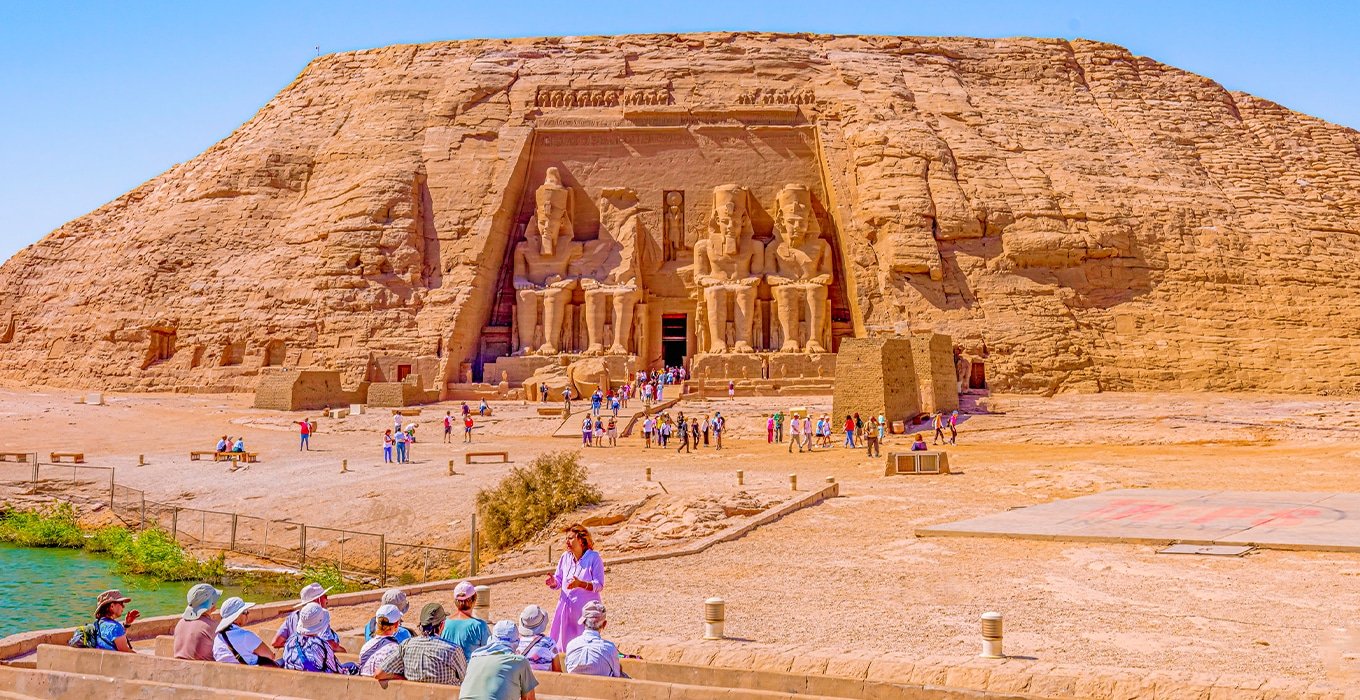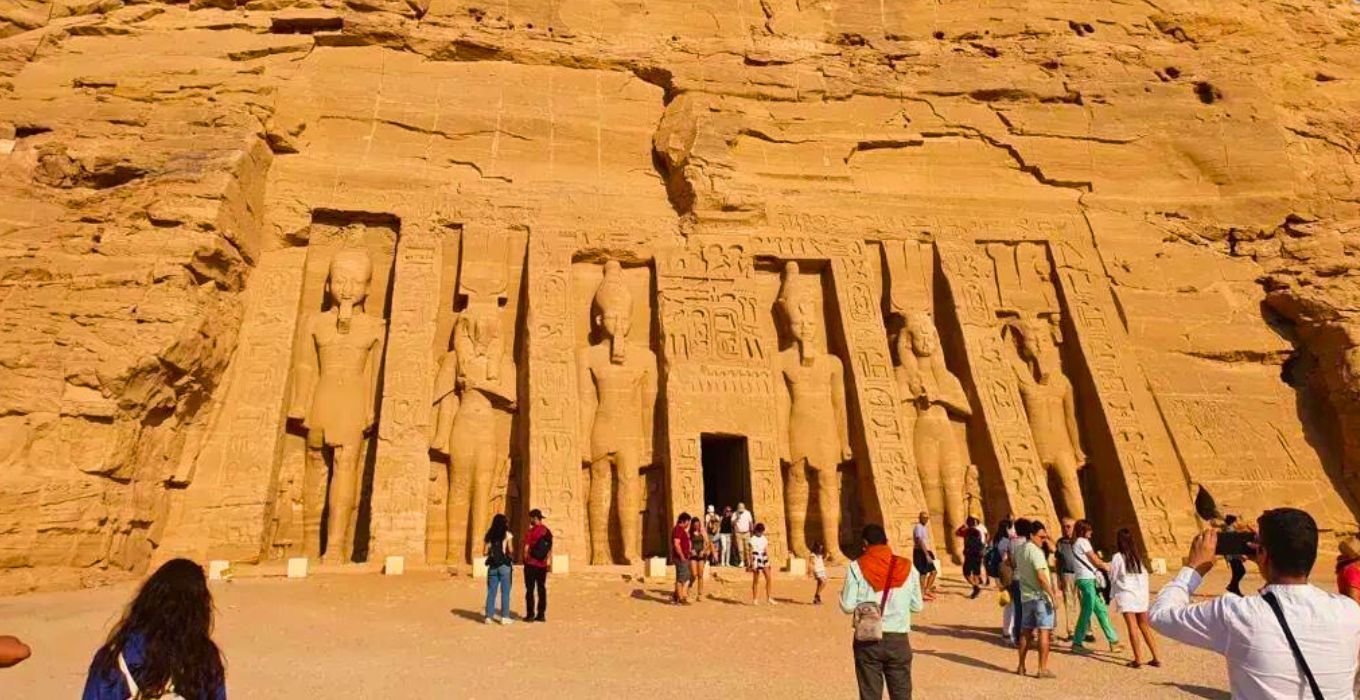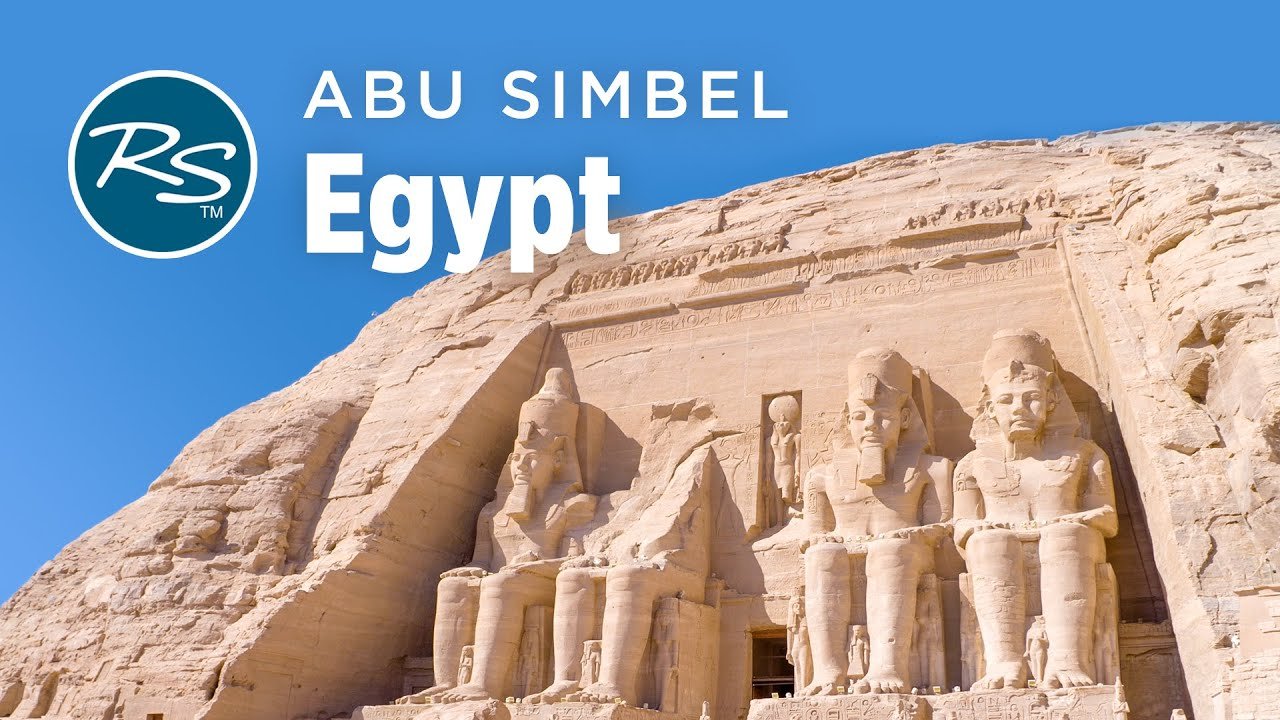In the Nubian Desert of southern Egypt, the Abu Simbel temple is a marvel. It shows the ancient Egyptians’ grandeur and engineering skills. This UNESCO World Heritage Site has huge statues of Pharaoh Ramesses II and his wife Nefertari. It has amazed many travelers and historians.
But what secrets does it hold? What can it tell us about the Nile River Valley’s rich culture?
Key Takeaways
- The Abu Simbel temple is a remarkable example of ancient Egyptian architecture, carved directly into the solid rock of the Nubian Desert.
- Commissioned by the powerful Pharaoh Ramesses II, the temple features colossal statues of the king and his wife Nefertari, showcasing their power and influence.
- The temple complex is a designated UNESCO World Heritage Site, recognized for its cultural significance and engineering achievements.
- Visitors to the Abu Simbel temple can explore its intricate reliefs and carvings, as well as witness the biannual solar alignment, a celestial spectacle that showcases the temple’s precise astronomical alignment.
- Exploring the Abu Simbel temple offers a unique opportunity to dive into the rich cultural heritage of ancient Egypt and the Nile River Valley.
Unraveling the Grandeur of Abu Simbel Temple
The Abu Simbel Temple is a wonder of Ancient Egyptian architecture. It shows the amazing skills of ancient builders. This huge temple, carved into the Nubian Desert rock, is a masterpiece of Pharaonic art and architecture.
A Marvel of Ancient Egyptian Architecture
The Abu Simbel Temple is a stunning example of ancient Egyptian rock-cut temples. Its massive size and detailed design are breathtaking. The temple’s entrance is guarded by huge statues of Ramesses II. The walls are covered in intricate carvings and reliefs, showing the incredible skill of its creators.
Carved into the Solid Rock of the Nubian Desert
The temple’s location is what makes it truly remarkable. It was carved into the solid rock of the Nubian Desert. This shows the ancient Egyptians’ engineering skills and determination. The temple overlooks the Nile River, adding to its grandeur and importance as a Nubian monument.
The Abu Simbel Temple’s impressive size, detailed carvings, and natural setting make it a masterpiece. It celebrates the ingenuity and artistic genius of the ancient Egyptians.

Ramesses II: The Pharaoh Behind the Masterpiece
The Abu Simbel Temple is a symbol of Ramesses II‘s vision and ambition. Known as Ramesses the Great, he built this temple to honor himself and the gods he worshipped.
Ramesses II ruled for over 60 years, leaving a mark with his military victories and grand projects. The Abu Simbel Temple shows his power and his wish to be remembered among the Pharaonic relics.
It was built between 1264 and 1244 BCE, to face the rising sun. This honored the sun god Ra-Horakhty. The temple’s construction in the Nubian Desert shows the ancient Egyptians’ engineering and art skills.
“The Abu Simbel Temple is a true masterpiece, a lasting monument to the enduring legacy of Ramesses II and the skilled artisans who brought his vision to life.”
Through the Abu Simbel Temple, Ramesses II wanted to be remembered as a legendary ruler and art patron. This ancient Egyptian monument still fascinates people worldwide, showing the grandeur of a remarkable pharaoh.
Abu Simbel Temple: A UNESCO World Heritage Site
The Abu Simbel Temple is a gem of ancient Egypt, named a UNESCO World Heritage Site in 1979. This honor highlights its huge historical, cultural, and architectural value. It’s a key spot for those exploring the Nubian Monuments.
Preserving a Timeless Wonder
In the 1960s, the Abu Simbel Temple was at risk from the Aswan High Dam. This dam would have flooded the site. Thanks to a huge effort, the temple was moved to a safer place. This shows the world’s dedication to saving this ancient marvel.
A Testament to Human Ingenuity
The move of the Abu Simbel Temple is seen as a top engineering feat of the 20th century. It took a lot of work to take apart and then put back together the huge structures. This shows how clever and determined people can be.
“The preservation of the Abu Simbel Temple is a shining example of our collective responsibility to safeguard the world’s cultural heritage for future generations.”
The Colossal Statues of Ramesses II and Nefertari
The Abu Simbel Temple shows the grandeur of ancient Egyptian rulers. It has four huge statues of Pharaoh Ramesses II, each over 60 feet tall. These massive sculptures, carved into the rock, are awe-inspiring and symbolize Ramesses II‘s lasting legacy.
The temple also has two impressive statues of Queen Nefertari, the pharaoh’s wife. This highlights the significant role of royal women in ancient Egyptian monuments. It also shows the deep respect for the pharaoh’s partner.
Awe-Inspiring Monuments to Pharaonic Glory
The statues of Ramesses II and Nefertari at Abu Simbel are a testament to ancient Egyptian ambition. These giant figures, carved from the Nubian Desert rock, remind us of the pharaonic civilization’s scale and skill.
|
Statue |
Height |
Significance |
|
Ramesses II |
Over 60 feet |
Symbolizes the might and power of the pharaoh |
|
Nefertari |
Approximately 35 feet |
Represents the importance of the royal consort in Egyptian society |
These colossal statues amaze visitors with their size. They also honor the legacy of Ramesses II and the deep respect for ancient Egyptian monuments and the pharaonic dynasty.
The Abu Simbel Temple’s Intricate Reliefs and Carvings
Step into the world of the Abu Simbel Temple. Its walls are filled with detailed reliefs and carvings. They take you back to ancient Egypt’s glory days.
The carvings show scenes of religious rituals, battles, and daily life. They are incredibly detailed. They let visitors dive into the stories of the Abu Simbel Temple.
The Rock-Cut Temples show the skill of Ancient Egyptian Architecture. They turned the land into a canvas for Pharaonic Relics. Get ready to see the amazing art on the temple’s walls. It’s a true wonder of the Nile River Valley’s culture.
Exploring the Nile River Valley’s Ancient Wonders
The Nile River Valley in Egypt is filled with ancient wonders. You’ll find the famous Abu Simbel Temple and many other monuments. This place is where ancient Egypt’s culture began, offering a deep dive into history.
The Nile Valley is not just about the Abu Simbel Temple. It’s also home to many archaeological sites, temples, and monuments. Places like Aswan Attractions and Luxor offer a journey through Egypt’s past.
A Journey Through Egypt’s Rich Cultural Heritage
Traveling the Nile River Valley lets you see Egypt’s history up close. Ancient Egyptian Monuments show the creativity and power of the pharaohs. You can see amazing hieroglyphics, obelisks, and sculptures that show the ancient Egyptians’ skill.
- Discover the hidden gems of the Nile River Valley, from the temple complexes of Aswan to the necropolis of Luxor
- Immerse yourself in the rich cultural heritage of ancient Egypt, where history and legend intertwine
- Explore the Ancient Egyptian Monuments that have stood the test of time, each one a testament to the ingenuity of their creators
Whether you’re drawn to the Abu Simbel Temple or the Aswan Attractions, this region is unforgettable. It’s a journey through Egypt’s heart, full of secrets waiting to be uncovered.

Abu Simbel Temple: A Highlight of Aswan Attractions
The Abu Simbel Temple is a key attraction in the Aswan area. It’s located about 200 miles south of Aswan. It’s perfect for a day trip or a Nile River cruise.
The temple’s setting in the Nubian Desert is breathtaking. Visitors get to see one of Egypt’s most impressive ancient sites. They can dive into the rich history of the Nile River Valley.
|
Attraction |
Location |
Distance from Aswan |
|
Abu Simbel Temple |
Southern Egypt |
Approximately 200 miles |
Visiting the Abu Simbel Temple is a must for anyone exploring Egypt’s ancient wonders. It showcases the grandeur and creativity of ancient Egyptian civilizations. It’s a highlight of the Aswan region’s landscapes and history.
Witnessing the Biannual Solar Alignment
The Abu Simbel Temple in Egypt is famous for its amazing architecture and astronomy. It’s known for the biannual solar alignment on February 22 and October 22. This event shows the ancient Pharaonic Relics‘ advanced knowledge and skill in Ancient Egyptian Architecture.
On these days, the first sun rays light up the temple’s inner space. They shine on the huge statues of Ramesses II, Ra-Horakhty, and Amun. People from all over come to see this amazing sight. They want to see how the temple’s design matches the sun’s path.
A Celestial Spectacle at the Abu Simbel Temple
The temple’s design aligns perfectly with the sun on certain days. This shows the ancient Egyptians’ deep knowledge of astronomy. They used this knowledge to create their architectural wonders. This event is a beautiful mix of the Abu Simbel Temple and the universe, showing the Pharaonic Relics‘ creativity and respect.
“The Abu Simbel Temple’s solar alignment is a truly awe-inspiring experience, a testament to the genius of ancient Egyptian architects and their profound understanding of the heavens.”
Seeing this event leaves visitors amazed. They think about the lasting impact of Ancient Egyptian Architecture. They also see the deep connection between the Abu Simbel Temple and the universe’s rhythms that have fascinated people for centuries.
Practical Tips for Visiting the Abu Simbel Temple
Visiting the Abu Simbel Temple in Egypt needs careful planning. It’s about 200 miles south of Aswan. Here are some tips to enhance your visit:
- Book your visit in advance: The temple gets crowded, especially during solar alignment events. Get your tickets early to avoid missing out.
- Combine your visit with other Aswan attractions: Check out the Unfinished Obelisk and Philae Temple while you’re there. It’s a great way to see more of the area.
- Consider a Nile River cruise itinerary: Many people visit Abu Simbel on a Nile River cruise. It’s a great way to see more ancient sites and enjoy the journey.
Plan well and explore Aswan’s attractions to make your visit unforgettable. See the Abu Simbel Temple and discover Egypt’s Nubian culture.
Conclusion: Embracing the Timeless Allure of Egypt’s Ancient Marvels
The Abu Simbel Temple is a symbol of ancient Egypt’s lasting legacy. It’s a massive rock-cut temple with stunning statues and detailed carvings. It also aligns perfectly with the stars, drawing visitors from everywhere.
Seeing the Abu Simbel Temple is essential for anyone interested in Egypt’s history. It shows the grandeur of Pharaonic culture. It’s a must-see for anyone exploring Egypt’s rich past.
For a deeper dive into Egypt’s ancient wonders, book a Nile River cruise with Egypt Cruise Planners. This trip lets you see the ancient monuments along the Nile. You’ll uncover the secrets and marvels of this ancient civilization at your own pace.
Visiting the Abu Simbel Temple is unforgettable. You’ll be amazed by its grandeur, the detailed reliefs, and the solar alignment. It leaves a lasting mark on your heart and mind. Let Egypt’s ancient marvels inspire your own journey of discovery and wonder.
Read other related articles:

